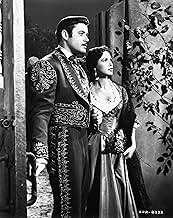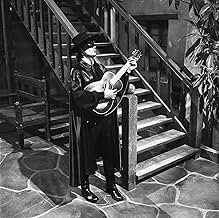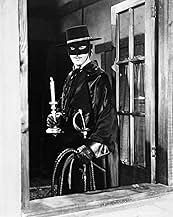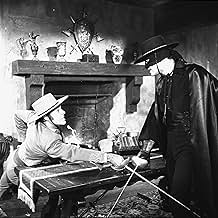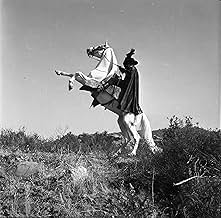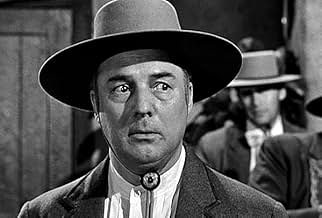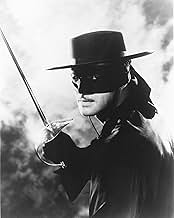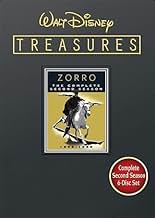Don Diego de la Vega kämpft als maskierter Schwertkämpfer Zorro gegen die korrupten Tyrannen im spanischen Kalifornien.Don Diego de la Vega kämpft als maskierter Schwertkämpfer Zorro gegen die korrupten Tyrannen im spanischen Kalifornien.Don Diego de la Vega kämpft als maskierter Schwertkämpfer Zorro gegen die korrupten Tyrannen im spanischen Kalifornien.
Folgen durchsuchen
Empfohlene Bewertungen
This show was a real treat, both on ABC from 1957 to 1959, and on the Disney Channel, with its blend of adventure and comedy. Excellent cast!
I am sorry that the series did not film further episodes, because it was superb. I saw it as a kid in syndication in 1965-66, and then again in 2002 on the Disney Channel.
"Zorro" had to have been the "Batman" of the late 1950s. Indeed, in the comic version of "Batman" it is Zorro whom Bruce Wayne considers his role model. After living in Texas and the Southwest, I can appreciate the series even more. I just wish Disney would bring it back, and that someone would revive the series. It was so interesting!
I am sorry that the series did not film further episodes, because it was superb. I saw it as a kid in syndication in 1965-66, and then again in 2002 on the Disney Channel.
"Zorro" had to have been the "Batman" of the late 1950s. Indeed, in the comic version of "Batman" it is Zorro whom Bruce Wayne considers his role model. After living in Texas and the Southwest, I can appreciate the series even more. I just wish Disney would bring it back, and that someone would revive the series. It was so interesting!
It is 1820 and a ship approaches the coast of Spanish California with young Don Diego de la Vega returning to his father's hacienda in the pueblo of Los Angeles. Recalled home after 3 years at University in Spain, Diego learns from the Capitan that the trouble his father hinted at in his letters is due to the political oppression of the new Commandante, Capitan Monastario. Realizing that he cannot hope to fight the soldiers as himself, Diego decides that "if one cannot wear the skin of the lion, put on that of the fox." By day he will appear to be a lazy, bookish, pacifist dandy. By night he will don the black clothes, a cape, and a mask and become the "Friend of the People", El Zorro, the Fox.
Although "Zorro" aired in the early days of television in B&W, it retains a fresh, modern quality, especially in the colorized version. In one half-hour show we get plot, action, comedy, drama, music, and even Spanish dancing. Everything was done under the guidance of Walt Disney and director Norman Foster with attention to detail, high production values, and Spanish flavor. The cast was wonderful, especially Henry Calvin as Sgt. Garcia, Gene Sheldon as the "deaf"-mute servant, Bernardo, George L. Lewis as Don Alejandro, Don Diamond as Cpl. Reyes, and co-star Britt Lomond as the evil Capitan Monastario. The author and inventor of Zorro, Johnston McCulley felt that the pages of his books had come to life in this show. Guy Williams, in the dual role of Diego/Zorro will never be surpassed as either. He remains for a generation of Babyboomers the real Zorro.
"Zorro" airs nightly on the Disney Channel. The 78 episodes are shown alternately all in B&W and then again in the colorized version. Even today it remains my favorite program on television.
Although "Zorro" aired in the early days of television in B&W, it retains a fresh, modern quality, especially in the colorized version. In one half-hour show we get plot, action, comedy, drama, music, and even Spanish dancing. Everything was done under the guidance of Walt Disney and director Norman Foster with attention to detail, high production values, and Spanish flavor. The cast was wonderful, especially Henry Calvin as Sgt. Garcia, Gene Sheldon as the "deaf"-mute servant, Bernardo, George L. Lewis as Don Alejandro, Don Diamond as Cpl. Reyes, and co-star Britt Lomond as the evil Capitan Monastario. The author and inventor of Zorro, Johnston McCulley felt that the pages of his books had come to life in this show. Guy Williams, in the dual role of Diego/Zorro will never be surpassed as either. He remains for a generation of Babyboomers the real Zorro.
"Zorro" airs nightly on the Disney Channel. The 78 episodes are shown alternately all in B&W and then again in the colorized version. Even today it remains my favorite program on television.
Thought I'd add my two cents. Along with Johnny Weismuller as Tarzan, Larry Buster Crabbe as Flash Gordon, Guy Williams is Zorro for me. He wasn't the first Zorro I saw in action, but after his, it is hard for me to watch some of the others. I believe he had a lot of potential and in the hands of the two directors he worked with, and the fencing master, they really brought a lot to the scripts and performance. Along with a wonderfully fleshed out supporting cast. I was also surprised to find Albert Whitlock's name in some of the end credits. He's the famous matte painter who has also work on many of Hitchcock's films. Also the stunt work for some of the episodes is quite impressive for a TV show, more of what I would expect to see in a feature film at that time.
I just bought the complete first season on DVD and I am surprised how much in tune my opinions are with the many positive things written about the show here already. If I'm ever blessed with a family, I truly look forward to watching these, along with Johnny's Tarzan, Buster's Flash and Clayton Moore's Lone Ranger with them. I have had the opportunity to watch a couple of the silent Super 8mm black and white films from the Zorro show with some kids I baby sat. If their reaction is any indication as to how my own family will enjoy and respond to watching these colorized versions on DVD, the experience will surely be a real treat for all of us.
I just bought the complete first season on DVD and I am surprised how much in tune my opinions are with the many positive things written about the show here already. If I'm ever blessed with a family, I truly look forward to watching these, along with Johnny's Tarzan, Buster's Flash and Clayton Moore's Lone Ranger with them. I have had the opportunity to watch a couple of the silent Super 8mm black and white films from the Zorro show with some kids I baby sat. If their reaction is any indication as to how my own family will enjoy and respond to watching these colorized versions on DVD, the experience will surely be a real treat for all of us.
"Zorro" was a character created in the image of others of the 19th century who had worn a disguise, played a dual role, championed justice for people against those who would deprive them of it or rob them through excessive taxes and deny them justice under courts. Johnston McCulley's character returned home in 1820, after attending a university in Spain, to find the land being ruled by a tyrannical commandante. Instead of committing suicide through a premature rebellion, Don Diego instead masquerades as a foppish coward by day--like the Scarlet Pimpernel--and by night becomes El Zorro, the black-clad fox. He is no altruist; his purpose is to steal back what the tyrant's soldiers have stolen, to save those condemned falsely and to instill a spirit of revolution against their oppressor in his people. McCulley apparently liked the television version much better than the film that had starred Tyrone Power; I too prefer it to that film as author and actor, and to the later versions. Producer Norman Foster and Walt Disney labored to make the production, albeit an adventure series, a quality offering, much as the British "Robin Hood" of Hannah Weinstein became a classic for the same reasons. As Diego de la Vega, Guy Williams, actually Hispanic, was a charismatic, attractive and capable "B" leading man in the role of a lifetime; he had the capability of playing comedy as well as drama and was made to seem a superb fencer. Henry Calvin played the slow-witted but practical Sergeant Garcia, Gene Sheldon was his mute servant and helper Bernardo, who also played the banjo. George J. Lewis, also Hispanic, was attractive as Don Alejandro, Diego's father; the part of Captain Monastario was played with some power by Britt Lomond; many other semi-regulars populated the series including Don Diamond, Jan Arvan, Jolene Brand, Nestor Paiva, Romney Brent, John Litel, Vinton Hayworth, Eduard Franz and Eugenia Paul. Others often seen in the series included regular guests Suzanne Lloyd Charles Korvin, Carlos Romero, Jay Novello and Michael Pate. Directors for the series included Charles Lamont, Harmon Jones, William Witney, John Meredyth Lucas, Norman Foster, Lewis R. Foster, Hollingsworth Morse, Charles Barton and Robert Stevenson. Among sixteen writers who contributed to the series' several; formats were Gene L. Coon, Roy Edward Disney, Anthony Ellis, Jackson Gillis, Lewis R. Foster, Norman Foster and N. B. Stone, Jr. George Avil supplied good B/W cinematography; Production Designer was Marvin Aubrey Davis aided by Set Decoratos Hal Gausman and Emile Kuri; Chuck Keehne supplied the attractive period costumes. Fred Cavens performed the vital job of fencing master. The theme song became as famous as the series did. This same show might have been done as drama; but as an adventure with sincerity, emotional honesty and good production values, it would be hard to better. The series appeared only from 1957 to 1959.
One might say this is quite possibly the most entertaining TV show ever created. "Zorro" has a rare combination of action, adventure, suspense, music, and even comedy. Though Guy Williams is only one of many men who have donned the mask of Zorro, he is considered by many, including me, to be the one true Zorro. Williams, though the true highlight of the show, was just part of a great cast. Gene Sheldon is a convincing "deaf" mute and we can always rely on Sergeant Garcia (Henry Calvin) for a few laughs. This show also is unique because even though it holds enough action and plot for adults, it is still mild enough for even very young children to watch and enjoy.
When "Zorro" originally aired on ABC from 1957-1959, it was a smash hit, knocking 5 of the 7 shows airing at the same time off the air. Unfortunately, due to legal problems with the rights of the show, only two full seasons of the show and four one-hour episodes were completed. But, on the bright side, "Zorro" can still be seen nightly on the Disney Channel.
When "Zorro" originally aired on ABC from 1957-1959, it was a smash hit, knocking 5 of the 7 shows airing at the same time off the air. Unfortunately, due to legal problems with the rights of the show, only two full seasons of the show and four one-hour episodes were completed. But, on the bright side, "Zorro" can still be seen nightly on the Disney Channel.
Wusstest du schon
- WissenswertesDuring the two year lawsuit between Disney and ABC that halted the series production, Disney kept Guy Williams on full salary.
- PatzerThe "avisos" or "Wanted" posters invariably announce the reward in "pesos". Although this brings to memory the post-independence Mexican peso, the name "peso" ("peso duro", etc) was used for centuries in the Spanish colonies for the Spanish Real or "piece-of-eight", and California was not an exception.
- Alternative VersionenAlso available in a computer colorized version.
- VerbindungenEdited into Zorro räumt auf (1958)
Top-Auswahl
Melde dich zum Bewerten an und greife auf die Watchlist für personalisierte Empfehlungen zu.
- How many seasons does Zorro have?Powered by Alexa
Details
- Laufzeit30 Minuten
- Farbe
- Sound-Mix
- Seitenverhältnis
- 1.33 : 1
Zu dieser Seite beitragen
Bearbeitung vorschlagen oder fehlenden Inhalt hinzufügen








